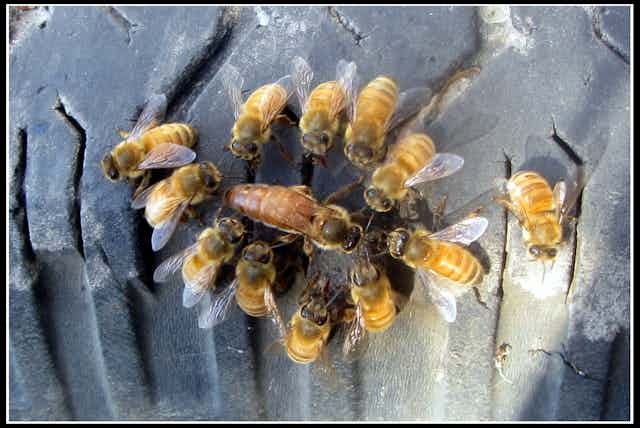Much like people, insect colonies like to know if her majesty is at home. In the ants, bees, wasps and termites (the “big four” of the social insect world), the queen has long been suspected of using special “queen pheromones” – emitted chemicals which let the workers know where she is.
Despite lots of circumstantial evidence that all social insects have queen pheromones, we mostly had no idea what those pheromones are – but a new paper published today in the journal Science changes that.
Queen pheromones are a very important part of the chemical language of the colony, and workers adjust not only their behaviour but their complete physiology when they smell their queen.
Workers deprived of queen pheromone assume that their mother is long gone and have a go at laying eggs themselves: queens usually handle almost all of the egg-laying in the colony.
Today’s paper, the result of collaboration between biologists and chemists working in Australia (me), Belgium and the US showed that by synthesising a copy of some possible queen pheromones, we could “trick” the workers into thinking their queen was still there.

A royal – yet common – perfume
We found the first queen pheromones from a wasp and a bumblebee, as well as a previously unstudied type of ant. Adding previous work, we’ve now found the queen pheromone of honeybees, termites and a few more ants.
This allowed us to ask a new question: do all social insects use the same queen pheromone, or does each have a unique version? Surprisingly, the answer is that queen pheromones are similar or even identical across species, even in distantly-related types of social insects.
Bees, ants and wasps all evolved colonial life (and the queen-worker dichotomy) independently, so many researchers expected them to have unique queen pheromones.
The fact that most bees, ants and wasps all have the same “chemical word” meaning “I’m the queen! I’m over here!” suggests that the pheromone existed in the most recent common ancestor of these species, which was a solitary insect that lived about 150 million years ago.
Maybe the pheromone was something used by female insects to signal that they were full of eggs (perhaps to attract the boys), and it was co-opted by primitive queens (who are also chock-full of eggs) to signal to their prototypical workers.
It all makes evolutionary scents
But why did all the social insects keep the same queen pheromone, instead of drifting apart and evolving very different ones over evolutionary time?
One possibility is that the latter actually did happen: the honey bee is an outlier, since it uses a very distinct, complicated queen pheromone all of its own.
Maybe once more queen pheromones are known, we will find other weird species that have switched to a new chemical language – but the current evidence suggests that most of the bees, ants and wasps stuck to the original queen pheromone, for reasons unknown.
The science drones are working on it: stay tuned!

